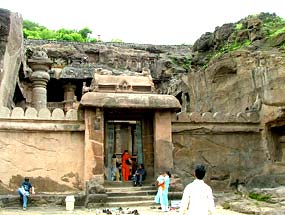Aurangabad Caves are situated on the outskirts
of the Aurangabad city of Maharashtra. Read about Aurangabad Caves
of India.
Aurangabad Caves

Location: Aurangabad, Maharashtra
Founded In: 2nd - 3rd century
Aurangabad caves are situated on the outskirts of the Aurangabad city
of Maharashtra. They lie in a valley, located between the Sihyachal and
Satara range of hills, which is irrigated by River Dudhna. There are
twelve caves in toto, which are basically categorized into three groups,
depending upon their location. The first group of caves consists of cave
number 1, 2, 3, 4 and 5, the second group comprises of cave number 6, 7,
8 and 9, while the last and the third group is made up of cave number
10, 11 and 12.
The distance between the first and second group of caves is
approximately 500 m. The first group of caves is situated on the western
side of a hill, while the second group lies on the eastern side of the
same hill. The third group of caves, outside the Aurangabad city, is
located to the east of the second group. The earliest excavations that
were carried out at the site came up with the cave number 1 and 3.
Aurangabad caves have been known to date back to somewhere around the
2nd - 3rd century.
The design of the cave number three represents a Chaitya Griha of the
Hinayana order of Buddhism. The heterogeneous nature of rock formation
in this cave has made it difficult to preserve the caves in a proper
manner. Since the rock formation is heterogeneous, the authorities have
also not been able to carry out large-scale excavations here. Many
portions of the caves, where the rock formations are wobbly, have been
left unearthed. Even cave number 1 is an unfinished vihara, with the
ceiling of its verandah having fallen down.
Cave number 2 also represents a vihara and has a shrine of Lord Buddha
at the rear. The rest of the Aurangabad Caves are usually attributed to
the reign of the Kalachuri dynasty. Of all the caves, cave number 7 is
the most intricately built and is also quite known for its sculptural
ornamentation. The cave has a shrine in the center, along with an outer
corridor that runs all around it. There are recesses, at regular
intervals, in the corridor. These recesses have been beautifully carved
with the images of Buddhist Gods and Goddesses.
The verandah of the cave has a splendid front wall, which stands
adorned with magnificent representation of a panel of litany of
Avalokitesvara and Bodhisattva, on either side of the entrance to the
shrine. The litany of Avalokitesvara, found in Aurangabad caves, is even
more detailed as well as intricate than the ones found in the Ajanta and
Ellora caves. It represents Bodhisattva Padmapani as the 'Savior of
Eight Great Perils' (Fire, Theft, Demon, Elephant, Lion, Shipwreck,
Snake and Monkey).
Apart from the panel mentioned above, the Aurangabad caves are adorned
with other impressive sculptural panels also. One such panel is that of
Tara, principal consort of Avalokitesvara. It has been illustrated to
the left of the central shrine door. Then, there is also a panel that
depicts a group of six female musicians on the left wall of the main
shrine, believed to be a representative sculptural panel of the
Aurangabad Caves. The main female, shown at the center of the panel, is
in a dancing mudra, while the five others are playing different musical
instruments. The remaining Aurangabad caves have incomplete excavations.


